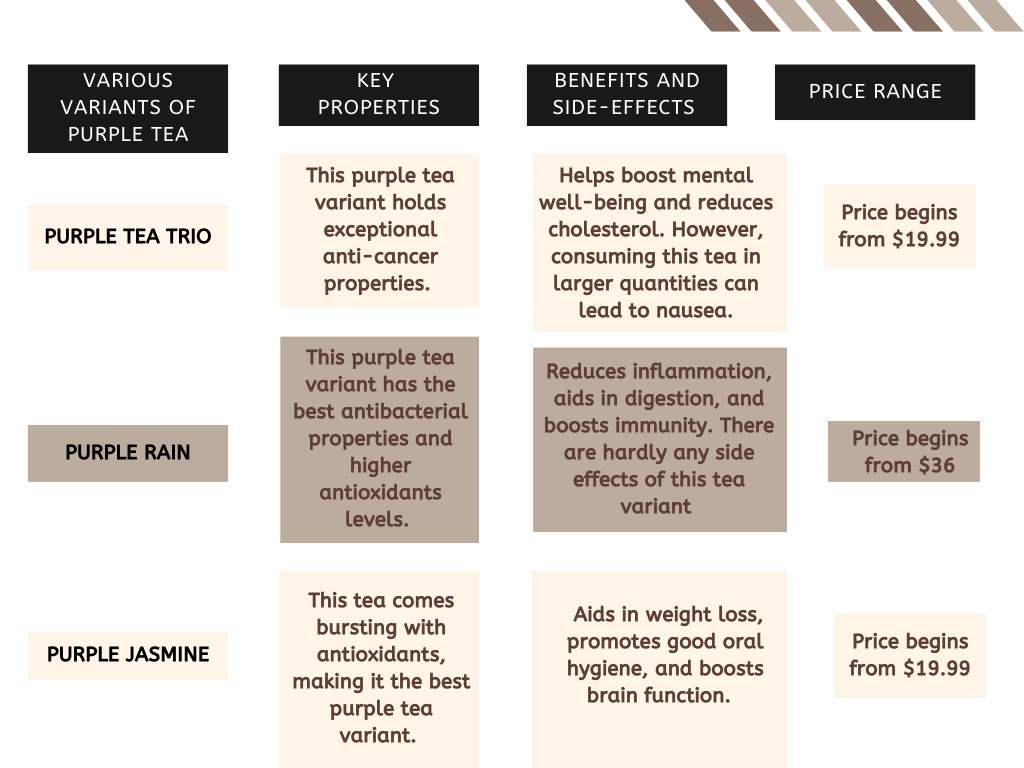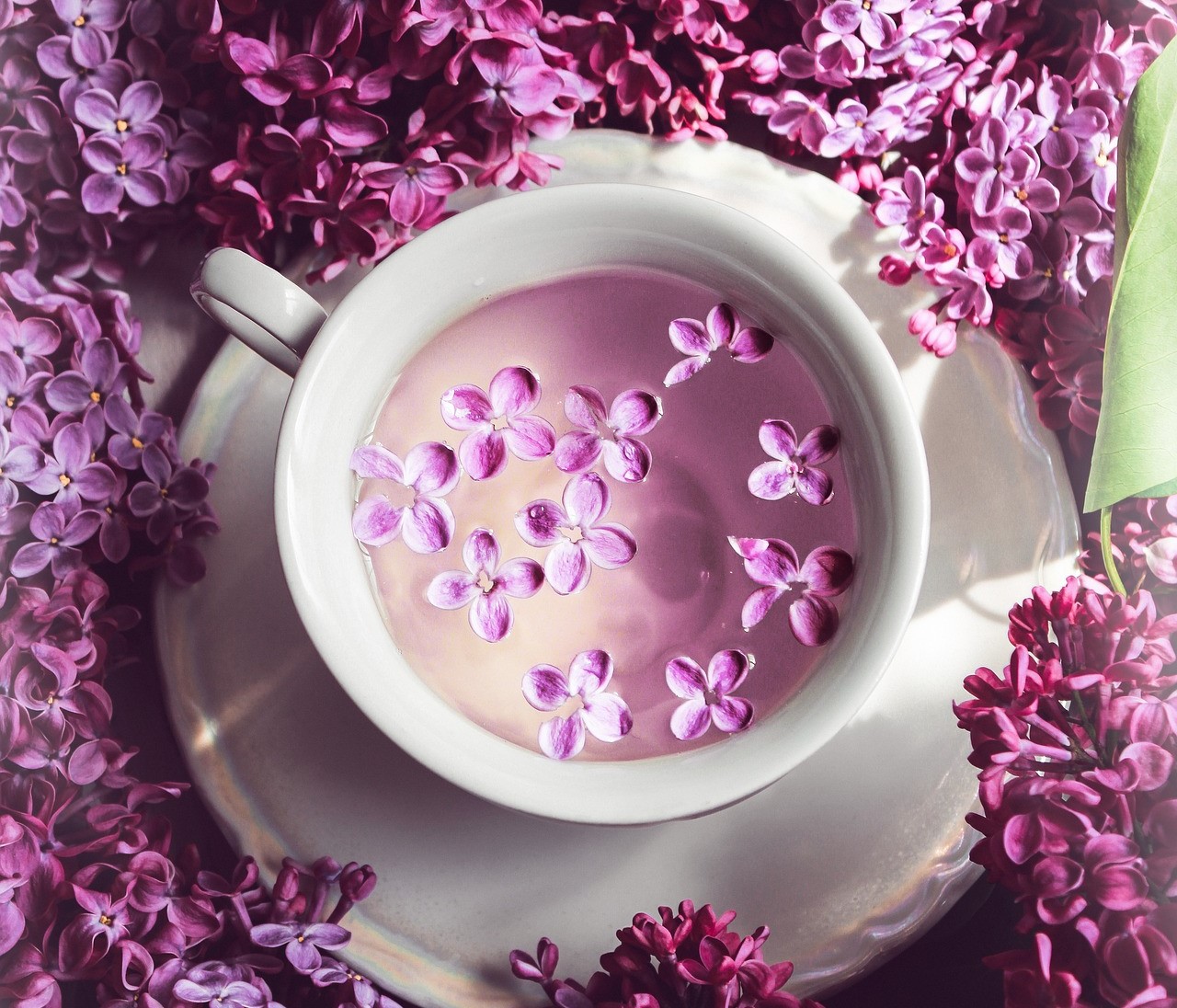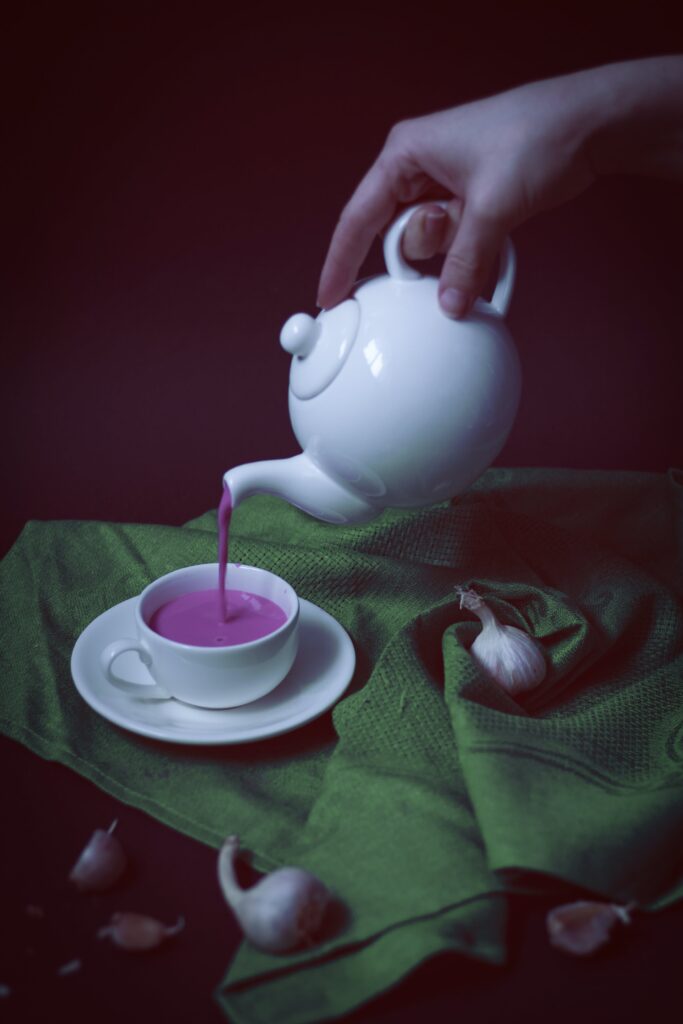Are you on the lookout for the next superfood to supercharge your health? Have you ever heard of the unique, vibrant brew known as purple tea? As a lesser-known cousin to green and black tea, purple tea is a fascinating beverage making waves in the wellness world.
Purple tea is a variant of Camellia sinensis, the plant species that gives us all types of tea. This enigmatic brew, grown predominantly in Kenya, is not only striking for its unusual color but also for the wealth of health benefits it’s purported to offer. Purple tea aids in weight loss and it is a powerhouse of antioxidants. It is also believed to be good for the eyes as well as cardiac health. Owing to these benfits, purple tea is quickly becoming the tea of choice for health enthusiasts and connoisseurs alike.
This blog post will delve into what makes purple tea a standout in the family of teas, exploring its origins, unique properties, and the wide-ranging benefits it can confer on your health. So if you’re interested in learning about how this vibrant beverage can give your health a boost, read on as we unravel the secrets of purple tea.
What is purple tea made up of?
Purple tea is a type of tea made from the Camellia sinensis plant, the same plant that gives us green, black, and oolong teas. What differentiates purple tea from other types of tea is the high concentration of anthocyanins, the pigments that give certain fruits and vegetables (like blueberries, raspberries, and eggplants) their distinctive colors. Anthocyanins are powerful antioxidants that have been associated with a number of health benefits.
Purple tea also contains several other health-promoting compounds. These include:
- Polyphenols: Polyphenols are micronutrients and antioxidants that help protect the body against free radical damage, which is linked to chronic diseases such as cancer and heart disease.
- Catechins: A type of polyphenol, catechins are another powerful antioxidant found in purple tea. They have been linked to a variety of health benefits, including reduced risk of heart disease and certain types of cancer.
- Epigallocatechin Gallate (EGCG): This is a specific catechin that is present in high amounts in purple tea. EGCG has been studied for its potential cancer-fighting properties.
- GHG (1,2-di-Galloyl-4,6-Hexahydroxydiphenoyl-B-D-Glucose): This is a unique compound found in purple tea but not in green or black tea. It’s believed to have anti-obesity effects by inhibiting the absorption of fats in the body.
- Caffeine and Theanine: Like other teas, purple tea also contains caffeine and theanine. Theanine is an amino acid that promotes relaxation and works synergistically with caffeine to promote alertness and cognitive function.
Given this rich cocktail of beneficial compounds, it’s not surprising that purple tea is being hailed as a superfood. However, more research is needed to fully understand all of its potential benefits.
ZOOMING IN TO PURPLE TEA AND ITS PROPERTIES
How is purple tea processed?
The processing of purple tea is similar to green tea but includes a unique additional step to preserve the purple color and its unique beneficial compounds. Here’s a simple overview of the process:
- Plucking: Like all types of tea, the process begins with the plucking of tea leaves. The top two leaves and bud, known as the ‘flush,’ are hand-picked from the Camellia sinensis plant.
- Withering: The plucked leaves are then spread out in thin layers in a process known as withering. This step allows some of the water to evaporate from the leaves, making them softer and more pliable for the subsequent rolling process.
- Rolling: The withered leaves are then rolled, which helps to break down the cell walls and release the enzymes and other compounds within the leaves. The rolling process also starts the oxidation process.
- Oxidation: Unlike black tea, which is fully oxidized, and green tea, which is not oxidized at all, purple tea undergoes minimal oxidation. This careful control of the oxidation process helps to maintain the purple color of the leaves and preserve the high anthocyanin content.
- Drying: After oxidation, the leaves are dried to stop the oxidation process and to reduce the moisture content so that the tea can be stored without spoiling.
- Sorting and Grading: The dried leaves are then sorted and graded based on size and quality. Only the highest quality leaves are sold as loose leaf purple tea.
This carefully controlled process allows the beneficial compounds within the purple tea leaves to be preserved, resulting in a final product that not only has a unique color but also a wealth of potential health benefits.
Is purple tea genetically modified?
No, purple tea is not a product of genetic modification. It’s a naturally occurring variety of the Camellia sinensis tea plant. The purple color comes from the high levels of anthocyanins, which are naturally occurring plant pigments found in many fruits and vegetables. It is
The purple tea plant is a result of a traditional plant breeding process that selectively bred tea plants with higher levels of anthocyanins over several generations. It was first developed by the Tea Research Foundation of Kenya (TRFK) in an effort to create a tea that could adapt to climate change, as the anthocyanins also help the plant to tolerate more sunlight, hence making it more resistant to climate variations.
So, you can enjoy your cup of purple tea knowing that it’s a product of nature’s wonder, bolstered by the careful and thoughtful work of traditional plant breeders.
What does purple tea taste like?
Purple tea has a distinctive flavor profile that is quite different from that of other teas like green or black tea. Its taste is often described as fresh and slightly sweet with a pleasant astringency. The flavor can also be woodsy or grassy, with notes of plum or blackberries, reflecting the high levels of anthocyanins which are also found in these fruits.
Unlike the bitter taste that can come from over-steeping green or black tea, purple tea tends to maintain its smooth and light taste even when steeped for a longer time. The exact flavor can vary depending on where the tea is grown and how it’s processed.
In terms of color, when brewed, purple tea can range from a light purple to a rich plum, and sometimes even a reddish or brown color depending on the pH level of the water used.
Given its unique taste and color, purple tea offers a novel tea drinking experience for both regular tea drinkers and newcomers alike.
Does purple tea have caffeine in it?
Yes, purple tea does contain caffeine, as it’s derived from the same plant that produces green, black, and oolong teas, all of which contain caffeine.
However, the exact caffeine content can vary depending on several factors, including where the tea is grown, how it’s processed, and how it’s brewed. In general, purple tea is thought to have a caffeine content that’s somewhat similar to or slightly lower than that of green tea, which typically contains less caffeine than black or oolong tea.
For reference, an average cup of green tea has around 25-35 milligrams of caffeine, compared to 50-90 milligrams in a cup of black tea, and 95 milligrams in a cup of coffee. These are averages and can vary, so if you are sensitive to caffeine or are trying to limit your intake, it’s always best to check the specific caffeine content with the tea producer or retailer.
While purple tea does contain caffeine, it also contains the amino acid L-theanine, which has been shown to promote a state of relaxed alertness. This means that the tea can give you a gentle boost without the jitters or crash often associated with other caffeinated beverages.
THE BENEFITS BASKET OF PURPLE TEA
What is purple tea good for?

Purple tea, with its unique blend of beneficial compounds, is associated with a number of potential health benefits:
- Rich in Antioxidants: Purple tea is particularly high in anthocyanins, which are powerful antioxidants that help to protect your cells against free radical damage. This could potentially reduce the risk of chronic diseases, such as heart disease and cancer.
- Promotes Weight Loss: Studies have suggested that purple tea may help with weight loss. A unique compound found in purple tea, GHG (1,2-di-Galloyl-4,6-Hexahydroxydiphenoyl-B-D-Glucose), is believed to have anti-obesity effects by inhibiting the absorption of fats in the body.
- May Improve Brain Health: Purple tea contains compounds that have been linked to improved brain health. These include the antioxidants catechins and anthocyanins, as well as the amino acid L-theanine, which is known for promoting relaxation and mental alertness.
- May Support Eye Health: The anthocyanins in purple tea have been linked to improved eye health. They may help protect the eyes from damage caused by blue light, and there’s some evidence suggesting that they could reduce the risk of age-related macular degeneration.
- May Support Heart Health: Purple tea is rich in flavonoids, which have been associated with a reduced risk of heart disease by improving factors like blood pressure and cholesterol levels.
- Potential Anti-Cancer Properties: Some studies have shown that the polyphenols found in purple tea may have anticancer properties. However, more research is needed in this area.
It’s important to note that while these potential benefits are promising, many of them are based on preliminary research and more studies are needed to fully understand the health benefits of purple tea. Additionally, drinking purple tea should complement, not replace, a balanced diet and healthy lifestyle for optimal health.
As with any health or nutrition-related decision, it’s always a good idea to consult with a healthcare provider or a registered dietitian to ensure it’s the right choice for you.
Is purple tea healthier than green tea?
Comparing the health benefits of purple tea and green tea isn’t exactly a straightforward task, as both offer a wealth of benefits due to their different beneficial compounds.
Green tea is renowned for its high concentration of powerful antioxidants called catechins, particularly epigallocatechin gallate (EGCG), which has been extensively researched for its potential benefits on heart health, weight management, and even certain types of cancer. It also contains caffeine and theanine, which work together to promote alertness and cognitive function.
On the other hand, purple tea contains all these beneficial compounds found in green tea, and additionally, it’s packed with anthocyanins, which are the pigments that give the tea its distinctive color. These anthocyanins, which are also found in blueberries and other purple or deeply colored fruits and vegetables, are potent antioxidants with potential anti-inflammatory, anti-viral, and anti-cancer benefits.
Moreover, purple tea contains a unique compound called GHG (1,2-di-Galloyl-4,6-Hexahydroxydiphenoyl-B-D-Glucose), which has been associated with anti-obesity effects. This compound is not found in green tea.
So, while green tea is undoubtedly healthy and has been the subject of extensive scientific research, early studies suggest that purple tea could potentially offer even more health benefits.
However, it’s important to note that research into purple tea is still relatively new, and more studies are needed to fully understand and substantiate its health benefits. As with any dietary choice, it’s wise to consume a variety of nutrient-dense foods (or teas) to obtain a broad spectrum of beneficial compounds.
How do you use purple tea on your face?

Purple tea is rich in antioxidants and has anti-inflammatory properties, which can be beneficial for your skin. Using purple tea topically on your face may help to soothe inflammation, protect against free radical damage, and even have anti-aging effects. Here’s how you can use it:
Purple Tea Face Toner:
- Brew the Tea: Start by brewing a cup of purple tea. Steep the tea for a bit longer than you would if you were drinking it, to make sure it’s strong. Once it’s brewed, let it cool down completely.
- Apply to Face: Once the tea is cool, you can apply it to your face using a cotton pad. Simply soak the cotton pad in the tea and gently wipe it over your face, avoiding the eye area.
- Let it Dry: Allow the tea to dry on your face. There’s no need to rinse it off — the beneficial compounds can remain on your skin.
- Follow with Moisturizer: After the tea has dried, you can follow with your usual skincare routine. A moisturizer can help to lock in the benefits of the tea.
Remember, before applying any new product to your face, it’s a good idea to do a patch test first. Apply a small amount to your inner arm and wait 24 hours to make sure you don’t have any adverse reactions.
Also, while purple tea can be beneficial for your skin, it shouldn’t replace a good skincare routine, which includes cleansing, moisturizing, and protecting your skin from the sun. Always consult with a dermatologist or skin care professional for personalized advice.
Is purple tea safe to drink?
Yes, purple tea is safe to drink for most people. Since it is another tea, just like green, black, and oolong teas, which are widely consumed around the world, it is generally considered safe unless someone has specific allergies or aversions.
Purple tea contains beneficial compounds like antioxidants and theanine, and while it does contain caffeine, the levels are typically lower than or similar to green tea, which is generally well-tolerated.
However, as with any caffeinated beverage, excessive consumption may lead to side effects such as restlessness, insomnia, or upset stomach. People who are sensitive to caffeine or have certain health conditions might need to limit their intake.
If you’re pregnant, breastfeeding, or have any specific health concerns, it’s always a good idea to consult with a healthcare provider before adding a new product like purple tea to your routine.
Keep in mind that while purple tea can be a part of a healthy diet, it’s not a magic cure-all and it’s best to consume it as part of a balanced diet and lifestyle for optimal health.
Is purple tea expensive?
Given its higher antioxidant levels and other exceptional properties, Purple tea variants remain pretty expensive than different tea types.
Mentioned below is a tabular representation of various variants of purple tea, their fundamental properties, benefits, and price range.

Apart from being delicious and refreshing, purple tea holds numerous advantages for our mind and body health.
This magical tea is an antioxidant-rich drink full of ingredients with advantageous properties, including boosting mind function, anti-inflammatory, anti-viral properties, and more that can refresh you from within and make you feel good about your everyday habits.
Conclusion
In conclusion, purple tea, with its unique anthocyanin-rich composition, offers a distinctive taste experience and a wealth of potential health benefits. From promoting weight loss and enhancing brain health, to its potential anti-cancer properties and skin benefits, this naturally-occurring variety of the Camellia sinensis plant presents an exciting alternative to traditional teas.
However, like any dietary choice, it should be enjoyed as part of a balanced lifestyle. More research is needed to fully understand its benefits, but it’s clear that purple tea is making a splash in the tea world.





